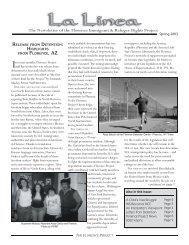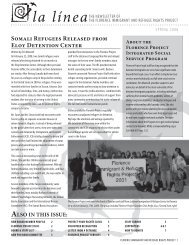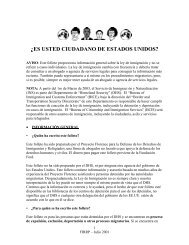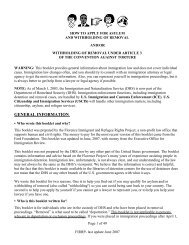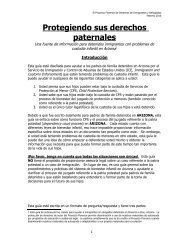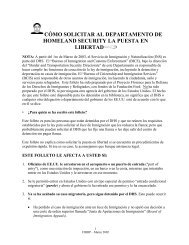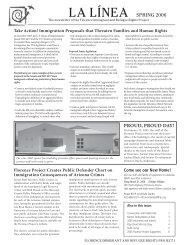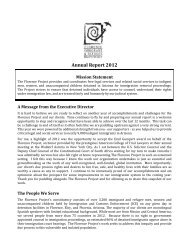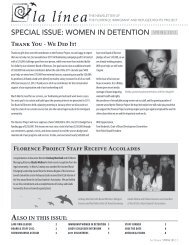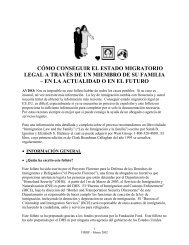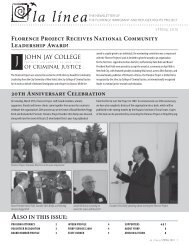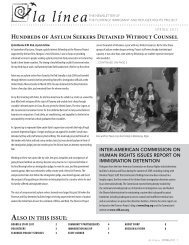quick reference chart and annotations for determining immigration ...
quick reference chart and annotations for determining immigration ...
quick reference chart and annotations for determining immigration ...
You also want an ePaper? Increase the reach of your titles
YUMPU automatically turns print PDFs into web optimized ePapers that Google loves.
Immigrant Legal Resource Center, Florence Immigrant <strong>and</strong> Refugee Rights Project,<br />
Maricopa County Public Defender August 2012<br />
Summary: If the victim is a minor, this can be a dangerous offense. Plead to disturbing the<br />
peace, or if needed to indecent exposure. Where possible leave the record vague as to the age of the<br />
victim if the victim was under 18. Immigration counsel will have strong arguments against this having<br />
consequences even where the victim was a minor, but they may not prevail <strong>and</strong> the person will be<br />
detained during the fight.<br />
Crime Involving Moral Turpitude (CMT): Maybe. This offense committed in front of an<br />
adult ought not to be held a CMT, because recklessness about the possibility of offending a person is not<br />
a CMT. While the government might charge this as a CMT where the victim was a minor, <strong>immigration</strong><br />
counsel at least have strong arguments against it. The only intent requirement is that the defendant was<br />
reckless as to whether a minor is present in the sense of being within viewing range, not whether it would<br />
alarm or offend the minor. Defense counsel should keep the language of the plea vague <strong>and</strong> avoid any<br />
<strong>reference</strong>s to the victim’s awareness of the offense or harm to the victim.<br />
Aggravated felony: Sexual Abuse of a Minor. Divisible. In Rebilas v. Mukasey, 527 F.3d<br />
783 (9th Cir. 2008) Rebilas v. Keisler, 506 F.3d 1161 (9th Cir. 2007), the Ninth Circuit found that a<br />
conviction <strong>for</strong> § 13-1403(B) was not categorically sexual abuse of a minor since the minor need not be<br />
aware of the conduct. The court noted that “[w]hen the minor is unaware of the offender's conduct, the<br />
minor has not been ‘abused’ as that term is commonly or generically defined, because the minor has not<br />
been physically or psychologically harmed.” Id. at 786. However, the <strong>immigration</strong> court may examine<br />
the record of conviction to determine whether the minor was aware of the conduct <strong>and</strong> there<strong>for</strong>e<br />
“abused.” Plead to the generic statutory language of the offense with no mention of the minor’s<br />
awareness of the conduct. If the record refers to the minor’s awareness, it may be better to plead to<br />
Indecent Exposure. Try to keep the age of the victim out of the factual basis <strong>and</strong> avoid a plea to (B)<br />
Other Grounds: DV/Child Abuse: The Board of Immigration Appeals has defined “child<br />
abuse” as an offense involving an “intentional, knowing, reckless, or criminally negligent act or omission<br />
that constitutes maltreatment of a person under 18 years old or that impairs such a person’s physical or<br />
mental well-being, including sexual abuse or exploitation.” Matter of Velazquez-Herrera, 24 I&N Dec.<br />
503 (BIA 2008). If the statute does not have as an element that the victim is under 18, it still may be a<br />
deportable crime of child abuse if the reviewable record of conviction establishes this fact. To prevent<br />
(A) from being a deportable crime of child abuse, do not let the record establish that the victim was under<br />
age 18.<br />
For (B) or <strong>for</strong> (A) when the record establishes minor age, under Rebilas, supra, <strong>immigration</strong><br />
counsel can argue that “child abuse” was not committed if the minor was unaware of the offender’s<br />
conduct. However, “child abuse” can also encompass unreasonably placing a child in a situation that<br />
poses a threat of injury to the child’s life or health even though no proof of actual harm or injury to the<br />
child is required. See Matter of Soram, 25 I&N Dec. 378 (BIA 2010). A plea to Indecent Exposure may<br />
be safer, but if this is not possible, try to avoid a plea to (B) <strong>and</strong> keep the victim’s age <strong>and</strong> the minor’s<br />
awareness of the conduct out of the record of conviction. See Note: Domestic Violence.<br />
23. Sexual Abuse, ARS § 13-1404<br />
“A person commits sexual abuse by intentionally or knowingly engaging in sexual contact with any<br />
person fifteen or more years of age without consent of that person or with any person who is under fifteen<br />
years of age if the sexual contact involves only the female breast.” “Without consent” may involve <strong>for</strong>ce<br />
or threat of <strong>for</strong>ce, the victim’s incapacity by drugs, etc. or inability to underst<strong>and</strong> the nature of the act, or<br />
deceit. See discussion of ARS §13-1406, infra. The mere fact of minority does not establish lack of<br />
consent. State v. Getz, 189 Ariz. 561, 564 (Ariz., 1997). "Sexual contact" means “any direct or indirect<br />
Arizona Criminal Chart with Explanatory Endnote – August 2012<br />
35



